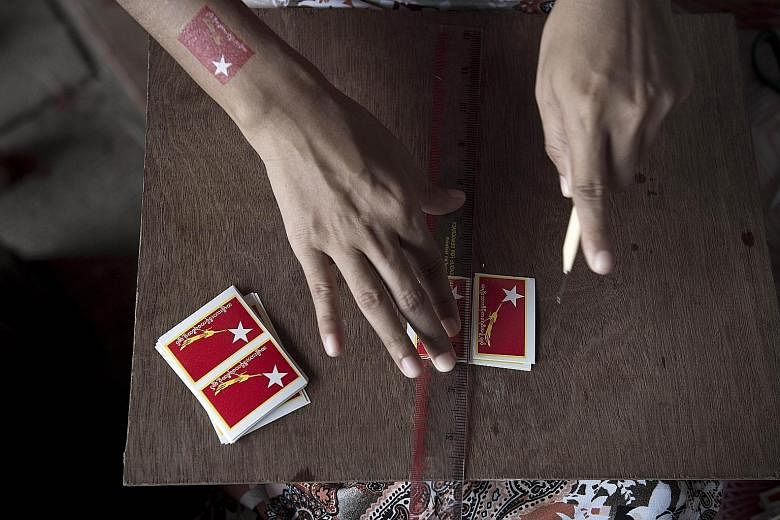YANGON • Bamboo hats, lions and fighting peacocks are just some of the colourful symbols that Myanmar's political parties are using to woo voters.
"A picture means more than 100 words," said Mr Sai Sam Phoon Seng, a campaign officer for the Shan Nationalities League for Democracy (SLND), one of about 90 parties registered for the Nov 8 polls. A symbol can catch "the eyes of the public", he said as volunteers in Yangon cut out stickers emblazoned with a roaring tiger head.
But for some observers, the focus on symbols at the expense of substantive debate in this campaign risks leaving voters short-changed.
-
KEY POINTERS TO THE NOV 8 VOTE:
-
MAIN PARTIES
• The National League for Democracy (NLD) is led by Nobel Peace Prize-winning democracy activist Aung San Suu Kyi, who first contested elections in 1990 while under house arrest. The Constitution bars her from becoming president as her immediate family members have foreign citizenship.
• The Union Solidarity and Development Party (USDP) is led by President Thein Sein and has guided the opening up of Myanmar since the junta was officially dissolved in 2011. Its ties to the military have sapped support for the party.
-
PROCESS
• About 30 million of Myanmar's 54 million people will be eligible to vote for 75 per cent of the 664 legislative seats.
• A quarter of the seats in both Houses of Parliament are reserved for military members appointed by the commander-in-chief, effectively providing them with a veto over major constitutional changes.
• The new legislature elects the president, with the two Houses of Parliament each proposing a candidate and a third offered by the military.
• The president does not have to be a lawmaker. The two candidates who do not make the cut become vice-presidents.
• The new president will not be selected until early next year.
-
CHALLENGES
• Civil unrest: While the government has made progress in peace talks with many of the main militant groups, a nationwide ceasefire accord that would consolidate 15 separate agreements has yet to be ratified and there is sporadic violence.
• Fractured constituencies: The NLD and the USDP tend to poll best in the country's heartland, and smaller ethnic parties dominate in areas near the borders.
• Disenfranchisement: More than one million ethnic Rohingya - who are effectively stateless - cannot vote.
-
ECONOMY
Annual growth has averaged more than 7 per cent since the 2010 election. The Asian Development Bank sees the economy expanding 8.3 per cent this year and close to that in 2016.
-
EXPERT'S SAY
"There is no clear-cut route to power for any of the individuals that currently dominate politics.The country can look forward to months of horse-trading over the presidency."
- Mr Herve Lemahieu, research associate at the International Institute for Strategic Studies.
BLOOMBERG
Mr Maung Zarni, a Myanmar analyst based in Britain, is concerned that the elections could prove a wasted opportunity to educate a public long starved of electoral debate. "In some places, people won't even know the name of the candidate (when they vote) but this is also driving unhappiness among more informed voters who want to know about policy," he said.
For the National League for Democracy (NLD), symbols do not come more powerful than its leader Aung San Suu Kyi - her image adorns everything from badges to fans at the fund-raising shop outside the party headquarters in north-east Yangon.
While the SNLD, locally known as the Tiger Head Party, is confident its distinctive logo would never be confused with that of its main rival - the prowling white tiger of the Shan Nationalities for Democratic Party (SNDP) - others think voters could end up bamboozled.
"At least half a dozen parties are using the fighting peacock symbol," said Khin Zaw Win of the Tampadipa Institute, a Yangon-based political think-tank, referring to NLD's emblem used in the 2012 by-elections which swept Ms Suu Kyi into Parliament.
AGENCE FRANCE-PRESSE

